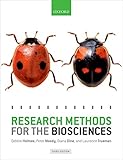Research methods for the biosciences / D. Holmes, P. Moody, D. Dine, L. Trueman.
Material type: TextPublisher: Oxford ; New York, NY : Oxford University Press, [2017]Edition: Third editionDescription: xxi, 460 pages : illustrations ; 25 cmContent type: text Media type: unmediated Carrier type: volumeISBN: 9780198728498; 0198728492Subject(s): Life sciences -- Research -- Methodology | Science | ScienceDDC classification: 570.7/2 LOC classification: QH315 | .H65 2017Other classification: 570.72
TextPublisher: Oxford ; New York, NY : Oxford University Press, [2017]Edition: Third editionDescription: xxi, 460 pages : illustrations ; 25 cmContent type: text Media type: unmediated Carrier type: volumeISBN: 9780198728498; 0198728492Subject(s): Life sciences -- Research -- Methodology | Science | ScienceDDC classification: 570.7/2 LOC classification: QH315 | .H65 2017Other classification: 570.72 | Item type | Current library | Call number | Copy number | Status | Notes | Date due | Barcode |
|---|---|---|---|---|---|---|---|
 Books
Books
|
Female Library | QH315 .H65 2017 (Browse shelf (Opens below)) | 1 | Available | STACKS | 51952000229902 | |
 Books
Books
|
Main Library | QH315 .H65 2017 (Browse shelf (Opens below)) | 1 | Available | STACKS | 51952000229896 |
Browsing Main Library shelves Close shelf browser

|

|

|

|
No cover image available |

|
No cover image available | ||
| QH 183 .E19 2006 Ecology and environment / | QH305 .G46 2015 The biology book : from the origin of life to epigenetics, 250 milestones in the history of biology / | QH313 .L68 2016 Gaia : a new look at life on earth / | QH315 .H65 2017 Research methods for the biosciences / | QH321 .B66 2015 Stations in the field : a history of place-based animal research, 1870 - 1930 / | QH324.2 .Z84 2008 Understanding bioinformatics / | QH325 .C36 2016 The big picture : on the origins of life, meaning, and the universe itself / |
Includes bibliographical references (page 456) and index.
Section 1: Planning your experiment. 1. Where do I begin? -- 2. Planning your experiment -- 3. Questionnaires, focus groups, and interviews -- 4. Research, the law, and you -- Section 2: Handling your data. 5. What to do with raw data -- 6. An introduction to hypothesis testing -- 7. Which statistical test should I choose? -- 8. Hypothesis testing: do my data fit an expected ratio? -- 9. Hypothesis testing: associations and relationships -- 10. Hypothesis testing: do my samples come from the same population? Parametric data -- 11. Hypothesis testing: do my samples come from the same population? Non-parametric data -- Section 3: Reporting your results. 12. Reporting your research
Demystifies the process of research and describes all the factors that enable effective investigation. These include planning your experiment; data collection, analysis, interpretation, and reporting; and legal, ethical, and health & safety considerations.
1 2

There are no comments on this title.